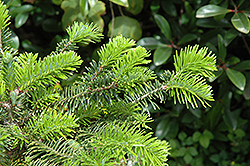Height: 40 feet
Spread: 30 feet
Sunlight:
![]()
![]()
Hardiness Zone: 4
Description:
An interesting species of fir native to Yunnan in southwest China and Tibet; a slow growing mountain tree that tends to grow taller at lower elevations; an elegant and unique selection as a landscape focal point with its glossy green foliage
Ornamental Features
Delavay's Fir is primarily valued in the landscape for its ornamental upright and spreading habit of growth. It has attractive dark green foliage with white undersides. The glossy needles are highly ornamental and remain dark green throughout the winter. The smooth gray bark adds an interesting dimension to the landscape.
Landscape Attributes
Delavay's Fir is a dense evergreen tree with a strong central leader and an upright spreading habit of growth. Its relatively fine texture sets it apart from other landscape plants with less refined foliage.
This is a relatively low maintenance tree, and usually looks its best without pruning, although it will tolerate pruning. It has no significant negative characteristics.
Delavay's Fir is recommended for the following landscape applications;
- Accent
- Windbreaks and Shelterbelts
Planting & Growing
Delavay's Fir will grow to be about 40 feet tall at maturity, with a spread of 30 feet. It has a low canopy, and should not be planted underneath power lines. It grows at a slow rate, and under ideal conditions can be expected to live for 50 years or more.
This tree does best in full sun to partial shade. It does best in average to evenly moist conditions, but will not tolerate standing water. It is not particular as to soil type or pH. It is somewhat tolerant of urban pollution, and will benefit from being planted in a relatively sheltered location. Consider applying a thick mulch around the root zone in both summer and winter to conserve soil moisture and protect it in exposed locations or colder microclimates. This species is not originally from North America.
